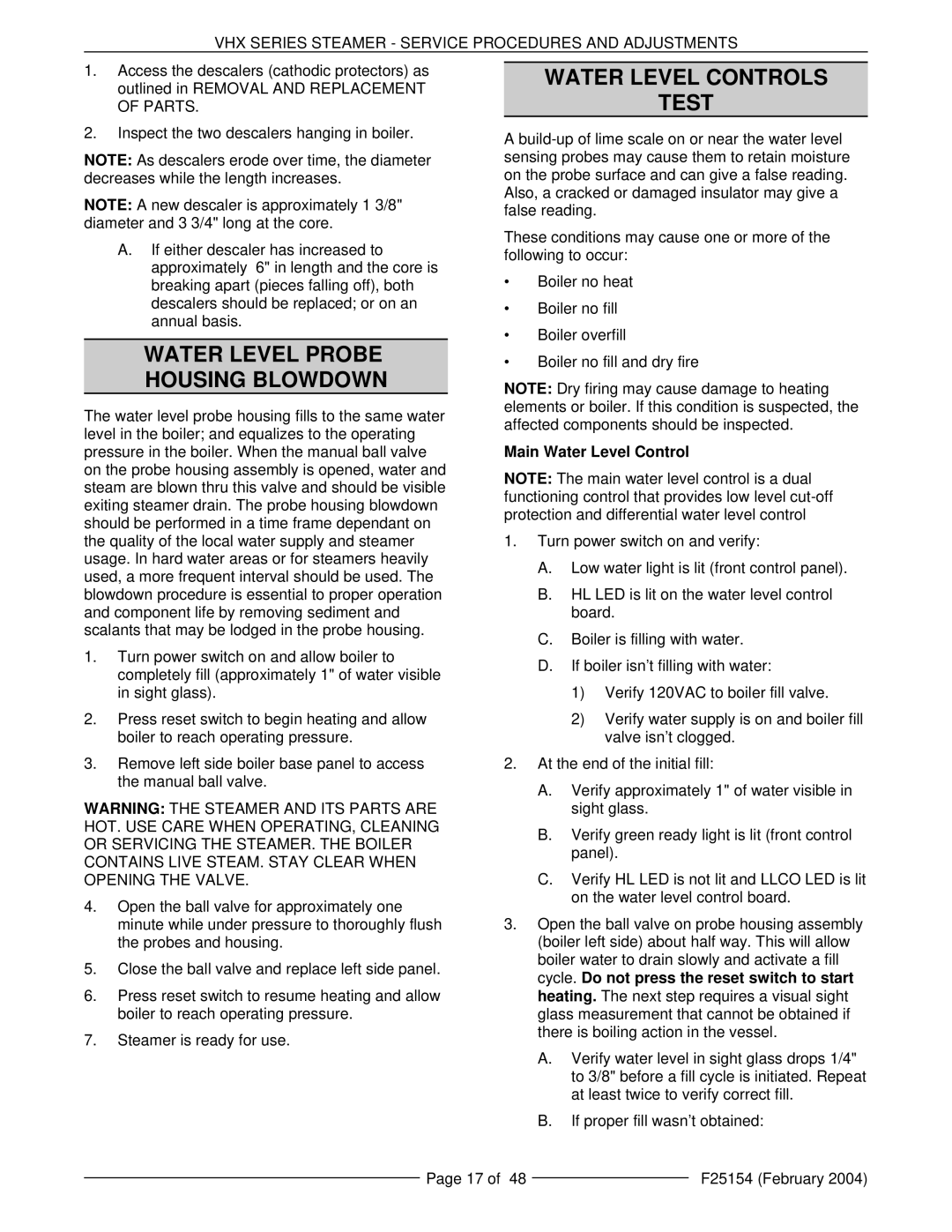
VHX SERIES STEAMER - SERVICE PROCEDURES AND ADJUSTMENTS
1.Access the descalers (cathodic protectors) as outlined in REMOVAL AND REPLACEMENT OF PARTS.
2.Inspect the two descalers hanging in boiler.
NOTE: As descalers erode over time, the diameter decreases while the length increases.
NOTE: A new descaler is approximately 1 3/8" diameter and 3 3/4" long at the core.
A.If either descaler has increased to approximately 6" in length and the core is breaking apart (pieces falling off), both descalers should be replaced; or on an annual basis.
WATER LEVEL PROBE
HOUSING BLOWDOWN
The water level probe housing fills to the same water level in the boiler; and equalizes to the operating pressure in the boiler. When the manual ball valve on the probe housing assembly is opened, water and steam are blown thru this valve and should be visible exiting steamer drain. The probe housing blowdown should be performed in a time frame dependant on the quality of the local water supply and steamer usage. In hard water areas or for steamers heavily used, a more frequent interval should be used. The blowdown procedure is essential to proper operation and component life by removing sediment and scalants that may be lodged in the probe housing.
1.Turn power switch on and allow boiler to completely fill (approximately 1" of water visible in sight glass).
2.Press reset switch to begin heating and allow boiler to reach operating pressure.
3.Remove left side boiler base panel to access the manual ball valve.
WARNING: THE STEAMER AND ITS PARTS ARE HOT. USE CARE WHEN OPERATING, CLEANING OR SERVICING THE STEAMER. THE BOILER CONTAINS LIVE STEAM. STAY CLEAR WHEN OPENING THE VALVE.
4.Open the ball valve for approximately one minute while under pressure to thoroughly flush the probes and housing.
5.Close the ball valve and replace left side panel.
6.Press reset switch to resume heating and allow boiler to reach operating pressure.
7.Steamer is ready for use.
WATER LEVEL CONTROLS
TEST
A
These conditions may cause one or more of the following to occur:
•Boiler no heat
•Boiler no fill
•Boiler overfill
•Boiler no fill and dry fire
NOTE: Dry firing may cause damage to heating elements or boiler. If this condition is suspected, the affected components should be inspected.
Main Water Level Control
NOTE: The main water level control is a dual functioning control that provides low level
1.Turn power switch on and verify:
A.Low water light is lit (front control panel).
B.HL LED is lit on the water level control board.
C.Boiler is filling with water.
D.If boiler isn’t filling with water:
1)Verify 120VAC to boiler fill valve.
2)Verify water supply is on and boiler fill valve isn’t clogged.
2.At the end of the initial fill:
A.Verify approximately 1" of water visible in sight glass.
B.Verify green ready light is lit (front control panel).
C.Verify HL LED is not lit and LLCO LED is lit on the water level control board.
3.Open the ball valve on probe housing assembly (boiler left side) about half way. This will allow boiler water to drain slowly and activate a fill cycle. Do not press the reset switch to start heating. The next step requires a visual sight glass measurement that cannot be obtained if there is boiling action in the vessel.
A.Verify water level in sight glass drops 1/4" to 3/8" before a fill cycle is initiated. Repeat at least twice to verify correct fill.
B.If proper fill wasn’t obtained:
Page 17 of 48 |
| F25154 (February 2004) |
|
